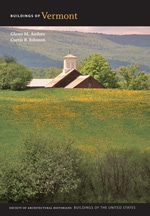
This wood-frame, gambrel-roofed barn with circular rooftop ventilators is notable for its L-shaped plan. It exemplifies the mainstream ground-stable dairy barns promoted by the U.S. Agricultural Extension Service beginning in 1914. The barn sits on a large farm that covers Clark Point and Hog Island on Lake Champlain. French Canadian Paul Tiel erected the barn's southern section in 1930 to house and feed one hundred cows. By expanding his dairy, Tiel, like many Champlain Valley farmers, successfully weathered the Great Depression. In 1941 he doubled the size of his dairy to two hundred and added the nearly identical north-facing section of the ell. Unlike earlier dairy barns, and similar to most later ground-stable barns, Tiel's barn relied on mechanical means to fill the huge one-and-a-half-story, gambrel-roofed hayloft. The ground-floor stable scheme of washable concrete floors and a separate milk house reflects sanitation requirements legislated in Connecticut, Massachusetts, and New York for milk shipped to urban markets in these states.

